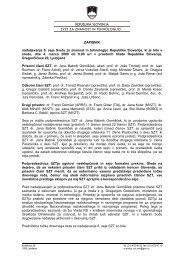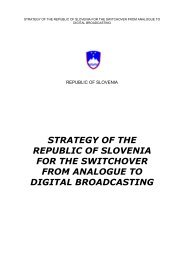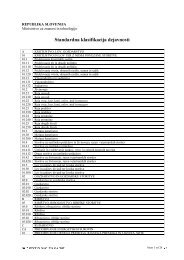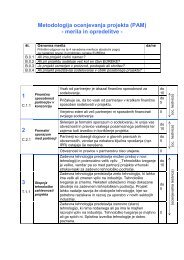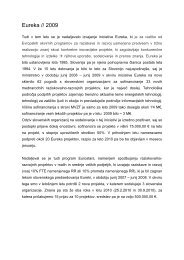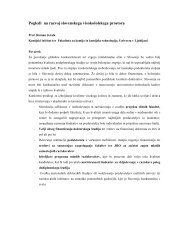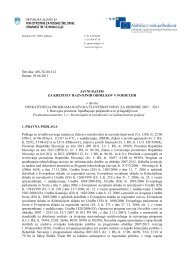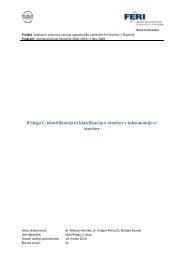Research and Innovation Strategy of Slovenia 2011-2020
Research and Innovation Strategy of Slovenia 2011-2020
Research and Innovation Strategy of Slovenia 2011-2020
- No tags were found...
You also want an ePaper? Increase the reach of your titles
YUMPU automatically turns print PDFs into web optimized ePapers that Google loves.
33 Encouragement <strong>of</strong> interstatemobility <strong>of</strong> researchers- elimination <strong>of</strong>administrative, technical<strong>and</strong> tax barriers forinternational mobility inboth directions- systematic measures forencouragement <strong>of</strong>international mobility inboth directions, inter alia- forming internationalcompatibility <strong>of</strong>mechanisms for recognition<strong>of</strong> researchers'qualificationsGovernment <strong>of</strong> the RS(science, highereducation, technology,innovations)<strong>2011</strong>–<strong>2020</strong>Share <strong>of</strong> PhDs who have for atleast three months studied,worked or researched abroadin the last 10 yearsShare <strong>of</strong> researchers withforeign citizenship among allthe researchersShare <strong>of</strong> foreign studentsamong the new PhDs34 Action Plan for ImprovingCareer Opportunities for<strong>Research</strong>ers in all the CareerPeriods, <strong>and</strong> for Ensuring theGender Equality PrincipleGovernment <strong>of</strong> the RS(science, technology,innovations)2012 Adoption <strong>of</strong> the Action Plan4.2 SpecializationExcellency on the world-wide basis is necessary for successfulness in the global world.Similar to comparative advantages in economy theory, a lack <strong>of</strong> critical mass <strong>and</strong> limitedresources in smaller <strong>and</strong> less developed regions due to complexity <strong>of</strong> scientific problems,<strong>and</strong> due to the size <strong>of</strong> necessary investments in the infrastructure, speak in support <strong>of</strong>knowledge <strong>and</strong> competencies concentration in the selected fields. Such a concept <strong>of</strong>specialization <strong>of</strong> a country or <strong>of</strong> a region that exploits local advantages, given features,characteristics, <strong>and</strong> prior investments into the establishment <strong>of</strong> capacities <strong>and</strong> <strong>of</strong>scientific excellence, enables the development <strong>of</strong> quality domestic competences <strong>and</strong>leading position in these areas upon the most optimal use <strong>of</strong> financial resources.State <strong>of</strong> affairsThe Resolution on the NRDP 2006-2010 followed the example <strong>of</strong> Central Europeanpriorities <strong>and</strong> provided five broad priority fields (information <strong>and</strong> communicationtechnologies, advanced (new-emerging) synthetic metallic <strong>and</strong> non-metallic materials<strong>and</strong> nanotechnologies, complex systems <strong>and</strong> innovative technologies, technologies forsustainable economy, health <strong>and</strong> life sciences). At the same time, it also definednarrower technological fields by means <strong>of</strong> technological feasibility studies. It has beenforeseen that the SZT after a two year period, executes a detailed evaluation <strong>of</strong> prioritysetting, <strong>and</strong> complements the list <strong>of</strong> priorities where necessary.The broadly identified fields in the NRDP 2006-2010 could not provide for implementation<strong>of</strong> the concept <strong>of</strong> the specialization. For this reason, the funding for research <strong>and</strong>development has been spread around a wide spectre <strong>of</strong> activities in a balanced way until2009, which interfered with the establishment <strong>of</strong> a critical mass <strong>of</strong> capacities that wouldensure a possibility <strong>of</strong> quality in a global context.Although the Council for Science <strong>and</strong> Technology did not carry out the evaluation <strong>of</strong>priority fields, the past years have been marked with numerous attempts for set outnarrower thematic priority fields. The Study on »Technological Foresights <strong>and</strong> SloveneDevelopment Priorities« (2008, Institute <strong>of</strong> Economic <strong>Research</strong>) <strong>and</strong> the documents onNational Technological Platforms were based on qualitative analyses, complemented byquantitative data on implementing enterprises, <strong>and</strong> on research groups <strong>and</strong> theircompetencies. The Report on Results <strong>of</strong> Identification <strong>of</strong> Narrow Priority DevelopmentThemes (2008, TIA - Technology Development Agency), <strong>and</strong> the recommendations <strong>of</strong> thegovernmental counselling body The Competitiveness Council (2009) that are based onevaluations <strong>of</strong> a large number <strong>of</strong> co-operating experts from the economy <strong>and</strong> the science,are also important. Additional guidelines have been elaborated on the basis <strong>of</strong> the



